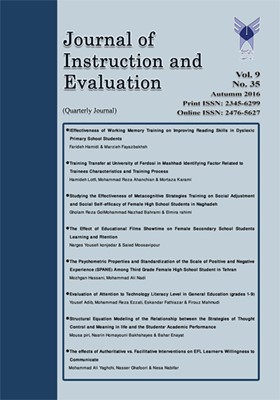ارزیابی میزان توجه به «سواد فناورانه» در آموزش و پرورش عمومی (پایههای 9-1)
الموضوعات :یوسف ادیب 1 , محمدرضا عزتی 2 , اسکندر فتحیآذر 3 , فیروز محمودی 4
1 - دکترای برنامهریزی درسی و استاد دانشکده علومتربیتی دانشگاه تبریز
2 - دانشجوی دوره دکتری برنامهریزی درسی دانشکده علومتربیتی دانشگاه تبریز
3 - دکترای تعلیم و تربیت و استاد دانشکده علومتربیتی دانشگاه تبریز
4 - دکترای برنامهریزی درسی و استادیاردانشکده علومتربیتی دانشگاه تبریز
الکلمات المفتاحية: تحلیل محتوا, سواد فناوری, آموزش فناوری, کار و فناوری,
ملخص المقالة :
این تحقیق با هدف تحلیل محتوای کتابهای درسی از نظر حضور عناصر سواد فناورانه و به روش تحلیل محتوا انجام شده است. جامعه آماری کلیه کتابهای دوره آموزش عمومی (پایههای 9-1) و نمونهگیری بر مبنای هدف بوده است. بر این مبنا، 24 کتاب درسی انتخاب و با استفاده از عناصر بیست گانه سواد فناوری محتوای آنها توسط دو معلم جداگانه کدگذاری و دادهها در جداول فراوانی توصیف و سپس مورد تجزیه و تحلیل قرار گرفت. براساس نتیجه این تحلیل، عناصر دانش فناوری برای درک ماهیت و اثرات فناوری در حدی بسیار ضعیف ارائه شده است. عناصر پرورش مهارتهای فرایندی فناورانه در حد قابل قبول وجود داشت، اما این فرایندها در ماهیت با فعالیتهایی که ذاتاً فناورانه خوانده میشوند، مانند طراحی و رفع نقص فاصله داشت. در زمینههای فناورانه نیز فناوری اطلاعات بیش از سه چهارم عناصر محتوایی را به خود اختصاص داده و سهم زمینههای دیگر اندک بود. بنابراین در مجموع میتوان پتانسیل برنامه درسی ملی جدید را برای پرورش سواد فناورانه در همه ابعاد آن ناکافی و ضعیف توصیف نمود.
References منابع
Bybee, R. (2003). Fulfilling a promise: Standards for technological literacy. The Technology Teacher, 23-26.
Cross, A., & McCormick, R. (1986). Technology in schools. Milton Keynes: Open University Press.
de Klerk Wolters, F. (1989). The attitude of pupils towards technology. Eindhoven: The Netherlands: Eindhoven University of Technology.
Dakers, J. (2006). Toward a philosophy for technology education. New York: Palgrave Macmillan.
Dugger, S. W. (1993). What are the relationship between Technology, Science and Mathmathics? In I. Mottier, J. R. Raat & M. De Vries, Technology Education and the Envirnment Improving Our environment through tecnology education (pp. 174-188). Eindhoven: PATT Foundation.
Dyrenfurth, M. J. (1991). Technology literacy synthesized. In M. J. Dyrenfurth. In M. J. Dyrenfurth & M. Kozak (Eds.), Technological literacy (pp. 138-183). Peoria, , IL: Glencoe/McGrawhill.
Faure, E., Herrera, F., Kaddoura, A. R., & Lopes, H. (1972). Learning to Be: The World of Education Today and Tomorrow. Paris/London.: UNESCO/ Harrap.
Frank, M. (2005). A systems approach for developing technological literacy. Journal of Technology Education, 17(1), 19-34.
Gilbert, J. K. (1992). The Interface between Science Education and Technology Education. International Journal of Science Education, 14(5), 563–578.
International Technology Education Association (ITEA). (1996). Technology for all Americans, a rational and structure for the study of technology. Reston: VA: Author.
International technology education association. (2002). Executive Summary of Standard for Technology literacy: Content for the Study of Technology. reston: ITEA.
Kelley, T., & Kellam, N. (2009). A theoretical framework to Guide the re-engineering of technology education. Journal of Technology Education, 20(2), 37-49.
LaPorte , J. E. (2001). Of melting pots, football drafts, and Professor Jackson. Journal of Technology Education, 12(2), 2-4.
Lewis, T. (2000). Technology Education and Developing Countries. International Journal of Technology and Design Education,10 (2), 163–179.
Mehrmohammadi, M. (2013). Recognition of “technology education” as a null aspect of school curriculum and an exigency in the Islamic world. Journal of Curriculum Studies (J.C.S.), 7(28), 117-138.
Papert, S. (1980). Mindstorms, children, computers and powerful ideas. New York: Basic Books Inc.
Rasinen, A. (2003). An Analysis of the Technology Education Curriculum of Six Countries. Journal of Technology Education , 15(1), 31-47.
Stables, K. (1997). Critical Issues to Consider When Introducing Technology Education into the Curriculum of Young Learners. Journal of Technology Education, 8 (2), 50-65.
Todd, R. (1991). The changing face of technology education in the United States. In J. J. Smith (Ed.), Papers and poster abstracts of the Fourth National Conference in Design (pp. 270-278). Loughborough,, UK: Department of Design and Technology, University of Technology.
Wicklein, R., Cameron , P., & Smith, J. (2009). Essential Concepts of Engineering Design Curriculum in Secondary Technology Education. Journal of Technology Education, 20(2), 65-80.
Williams, P. J. (2001). Design: The Only Methodology of Technology? Journal of Technology Education, 11(2), 34-5.


